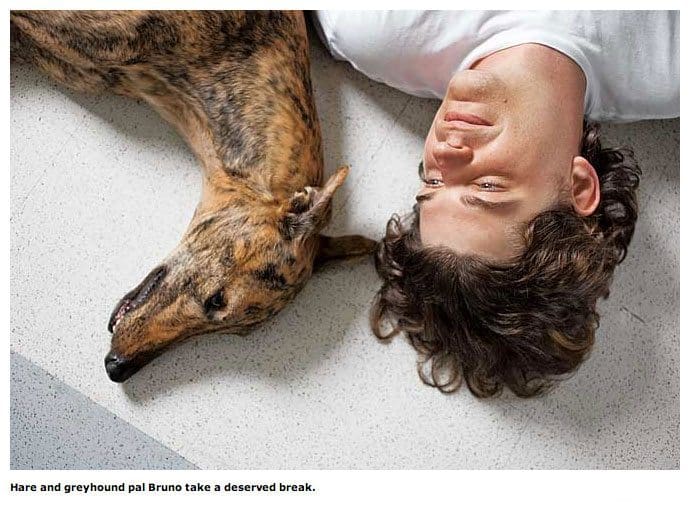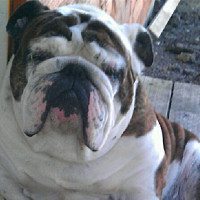This is a great story from this week’s Time Magazine. Seems we are about to learn more about our beloved canines then we’ve ever know before!
— Kenn Bell
 Brian Hare, assistant professor of evolutionary anthropology at Duke University, holds out a dog biscuit.
Brian Hare, assistant professor of evolutionary anthropology at Duke University, holds out a dog biscuit.
“Henry!” he says. Henry is a big black schnauzer-poodle mix–a schnoodle, in the words of his owner, Tracy Kivell, another Duke anthropologist. Kivell holds on to Henry’s collar so that he can only gaze at the biscuit.
“You got it?” Hare asks Henry. Hare then steps back until he’s standing between a pair of inverted plastic cups on the floor. He quickly puts the hand holding the biscuit under one cup, then the other, and holds up both empty hands. Hare could run a very profitable shell game. No one in the room–neither dog nor human–can tell which cup hides the biscuit.
Henry could find the biscuit by sniffing the cups or knocking them over. But Hare does not plan to let him have it so easy. Instead, he simply points at the cup on the right. Henry looks at Hare’s hand and follows the pointed finger. Kivell then releases the leash, and Henry walks over to the cup that Hare is pointing to. Hare lifts it to reveal the biscuit reward.
Henry the schnoodle just did a remarkable thing. Understanding a pointed finger may seem easy, but consider this: while humans and canines can do it naturally, no other known species in the animal kingdom can. Consider too all the mental work that goes into figuring out what a pointed finger means: paying close attention to a person, recognizing that a gesture reflects a thought, that another animal can even have a thought. Henry, as Kivell affectionately admits, may not be “the sharpest knife in the drawer,” but compared to other animals, he’s a true scholar.
It’s no coincidence that the two species that pass Hare’s pointing test also share a profound cross-species bond. Many animals have some level of social intelligence, allowing them to coexist and cooperate with other members of their species. Wolves, for example–the probable ancestors of dogs–live in packs that hunt together and have a complex hierarchy. But dogs have evolved an extraordinarily rich social intelligence as they’ve adapted to life with us. All the things we love about our dogs–the joy they seem to take in our presence, the many ways they integrate themselves into our lives–spring from those social skills. Hare and others are trying to figure out how the intimate coexistence of humans and dogs has shaped the animal’s remarkable abilities.
Trying to plumb the canine mind is a favorite pastime of dog owners. “Everyone feels like an expert on their dog,” says Alexandra Horowitz, a cognitive scientist at Barnard College and author of the new book Inside of a Dog: What Dogs See, Smell, and Know. But scientists had carried out few studies to test those beliefs–until now.
This fall, Hare is opening the Duke Canine Cognition Center, where he is going to test hundreds of dogs brought in by willing owners. Marc Hauser, a cognitive psychologist at Harvard University, recently opened his own such research lab and has 1,000 dogs lined up as subjects. Other facilities are operating in the U.S. and Europe.
The work of these researchers won’t just satisfy the curiosity of the millions of people who love their dogs; it may also lead to more effective ways to train ordinary dogs or–more important–working dogs that can sniff out bombs and guide the blind. At a deeper level, it may even tell us something about ourselves.


i taught my dog native american sign language & she could understand a whole sentence so to speak,but she knew my brother as “Pal”,it only took about 20 mins to do & if i said pal she went to the front door looking for him,taught her not to lick people(thats gross),she would instead nose ya,some unfortunate men have gotten a nose or paw in the crotch even though i warned them.but she had a weird habit i`ve not heard of other dogs doing>chases planes–runs & jumps growling & barking at it!! she even would go to other tenants cars when they came home & would escort them to the house,& would escort them to their cars when they were going somewhere,she did anything asked of her.i don`t believe in treating a dog to teach it something,she thrived on praise,hated being called a bad dog so she was always good/she did go to the “bad dog room”a few times–but not many.but it was funny to watch her when she heard a plane she would cock her head to hear where it was coming from & would scan the sky looking for them.she even took directions i tell her,they say never hook ya dog to ya bike by she loved it,on my push scooter too,she never pulled me off coarse. unfortunately that one in a million dog of 14 had to be put to sleep 2/1/11 from cancer in her mouth, & i could tell she wasn`t ready to leave this world but i couldn`t let her suffer,last nov. she was 90 lbs & by feb. she was only 54 lbs/she was pretty much bleeding to death from thr tumor.and i must go now cause i am sobbing as i type this out. GOOD-BYE MY GIRLIE 12/15/96—2/1/11